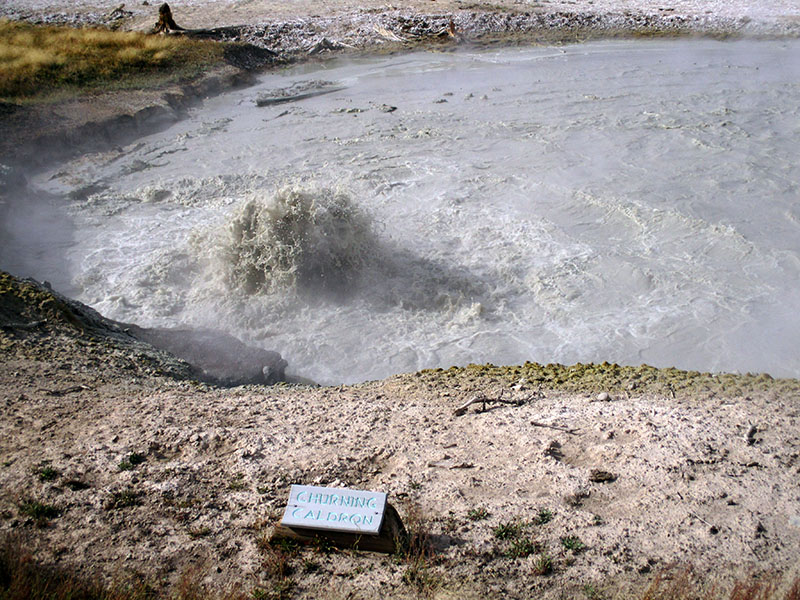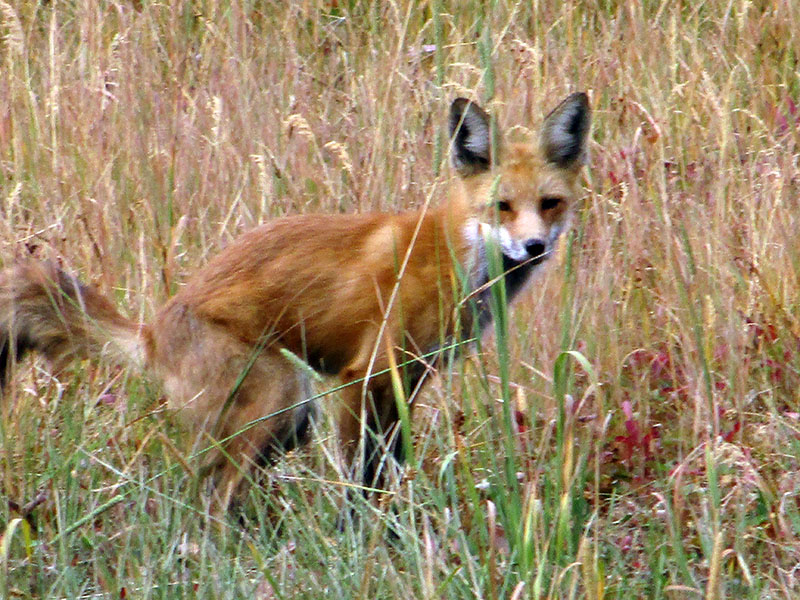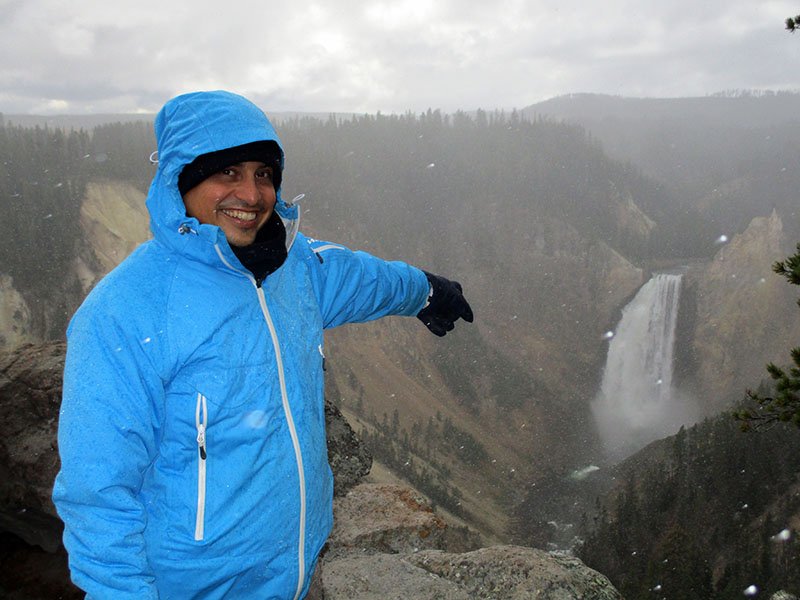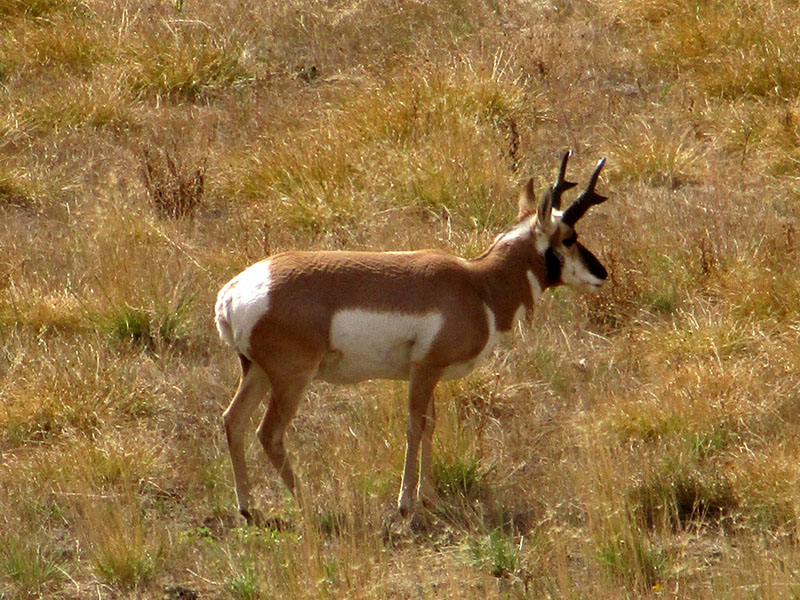 Thankfully, by the time we were ready to leave Grand Teton National Park, the road north to Yellowstone National Park had reopened from August’s Berry Fire. It didn’t take long to get to Yellowstone’s south entrance, from which we passed into lodgepole pine forest that had burned in an even larger fire in 1988. By now that area was showing good regrowth, but other, more barren patches, reflected more recent fires.
Thankfully, by the time we were ready to leave Grand Teton National Park, the road north to Yellowstone National Park had reopened from August’s Berry Fire. It didn’t take long to get to Yellowstone’s south entrance, from which we passed into lodgepole pine forest that had burned in an even larger fire in 1988. By now that area was showing good regrowth, but other, more barren patches, reflected more recent fires.
 We stopped first at the Grant Village Visitor Center to get our bearings. Yellowstone became a national park in 1872, and it was not only the first in this country but also the first in the world. While not the largest park (that distinction belongs to the 13,000-acre Wrangell-St. Elias National Park and Preserve in Alaska), Yellowstone’s 3,400 square miles still make for a lot of ground to cover. Between Yellowstone Lake, the world-famous Old Faithful geyser complex, the Grand Canyon of the Yellowstone River and its waterfalls, rugged mountains, alpine meadows and innumerable streams and smaller lakes, one could explore a different part of the park every year for a lifetime and still not see everything.
We stopped first at the Grant Village Visitor Center to get our bearings. Yellowstone became a national park in 1872, and it was not only the first in this country but also the first in the world. While not the largest park (that distinction belongs to the 13,000-acre Wrangell-St. Elias National Park and Preserve in Alaska), Yellowstone’s 3,400 square miles still make for a lot of ground to cover. Between Yellowstone Lake, the world-famous Old Faithful geyser complex, the Grand Canyon of the Yellowstone River and its waterfalls, rugged mountains, alpine meadows and innumerable streams and smaller lakes, one could explore a different part of the park every year for a lifetime and still not see everything.
 Even though Yellowstone has 900 miles of hiking trails, it seems designed for motorists. A figure-eight looping drive covers the highlights, and another five roads lead into the park from outside. For wildlife-watchers, Yellowstone is hard to beat, with animals seeming to appear at nearly every turn in the road.
Even though Yellowstone has 900 miles of hiking trails, it seems designed for motorists. A figure-eight looping drive covers the highlights, and another five roads lead into the park from outside. For wildlife-watchers, Yellowstone is hard to beat, with animals seeming to appear at nearly every turn in the road.
 We drove along the western shore of Yellowstone Lake to get to our campground at Bridge Bay. After setting up camp at the edge of the woods, we drove north along the road to the Canyon area and stopped at the Mud Volcano and Sulfur Cauldron areas to check out the geothermal action. In some places, like the Dragon’s Mouth and Churning Cauldron, we could hardly stomach the rotten-egg stench of the sulfurous vapors emanating from underground.
We drove along the western shore of Yellowstone Lake to get to our campground at Bridge Bay. After setting up camp at the edge of the woods, we drove north along the road to the Canyon area and stopped at the Mud Volcano and Sulfur Cauldron areas to check out the geothermal action. In some places, like the Dragon’s Mouth and Churning Cauldron, we could hardly stomach the rotten-egg stench of the sulfurous vapors emanating from underground.
 Our friend Ida had flown in to join us on our second day in the park. We left early to pick her up at the Cody airport, thinking we’d hike the Storm Point Trail on the way. As we walked toward Indian Pond, a herd of bison approached the trail from a sizable meadow to the west. They lingered at the pond for some 15 minutes, so we decided to abandon the hike rather than take the trail that abutted the pond.
Our friend Ida had flown in to join us on our second day in the park. We left early to pick her up at the Cody airport, thinking we’d hike the Storm Point Trail on the way. As we walked toward Indian Pond, a herd of bison approached the trail from a sizable meadow to the west. They lingered at the pond for some 15 minutes, so we decided to abandon the hike rather than take the trail that abutted the pond.
 At least that gave us time to stop off at several viewpoints on the road to the east entrance, as well as smaller, high-elevation lakes such as Sylvan Lake. The road climbed up to the rim of an enormous caldera, the remnants of enormous volcanic eruptions 640,000 years ago. At one dramatic overlook, we saw a black bear on the opposite hillside across the gorge (a good distance from which to view a bear). The drive down to Cody passed interesting rock formations, the North Fork of the Shoshone River, and Buffalo Bill Reservoir, all scenic spots in their own right.
At least that gave us time to stop off at several viewpoints on the road to the east entrance, as well as smaller, high-elevation lakes such as Sylvan Lake. The road climbed up to the rim of an enormous caldera, the remnants of enormous volcanic eruptions 640,000 years ago. At one dramatic overlook, we saw a black bear on the opposite hillside across the gorge (a good distance from which to view a bear). The drive down to Cody passed interesting rock formations, the North Fork of the Shoshone River, and Buffalo Bill Reservoir, all scenic spots in their own right.

We picked up Ida and headed back toward the park. Upon descending into the caldera, we saw more bison along the road, and a red fox greeted us as we approached our campsite. After Ida settled in, we returned to the Storm Point Trail for an afternoon hike.
 The now bison-free trail followed a golden meadow and led out to Yellowstone lake, then looped back around through lodgepole pine forest. Many of the trees stood intact but swaying and creaking above us in the high wind. Many more lay about on the forest floor as graying logs, giving the place a simultaneously eerie and enchanting feeling.
The now bison-free trail followed a golden meadow and led out to Yellowstone lake, then looped back around through lodgepole pine forest. Many of the trees stood intact but swaying and creaking above us in the high wind. Many more lay about on the forest floor as graying logs, giving the place a simultaneously eerie and enchanting feeling.
 The next day we drove the lower loop road that takes in the West Thumb, Old Faithful, Madison, Norris Geyser Basin, Canyon and Fishing Bridge areas. The Upper, Midway and Lower Geyser basins contain an incredible array of geysers, fumaroles, mud pots, paint pots and steaming pools. We began at Old Faithful, which erupted soon after we arrived. Several other geysers — Beehive, Sawmill and Giantess — impressed us even more as we walked along the Geyser Hill boardwalk.
The next day we drove the lower loop road that takes in the West Thumb, Old Faithful, Madison, Norris Geyser Basin, Canyon and Fishing Bridge areas. The Upper, Midway and Lower Geyser basins contain an incredible array of geysers, fumaroles, mud pots, paint pots and steaming pools. We began at Old Faithful, which erupted soon after we arrived. Several other geysers — Beehive, Sawmill and Giantess — impressed us even more as we walked along the Geyser Hill boardwalk.
 We motored on to the Black Sand and Biscuit Basin areas, which had wonderful hot pools in a steamy, multi-hued landscape. We also visited Grand Prismatic Spring in the Midway Geyser Basin and the Fountain Paint Pot area in the Lower Geyser Basin. The day had become increasingly cold and cloudy day with intermittent rain, so at each stop it became less fun to get out of the car. By the end of the day back at camp, the weather worsened and we had all-night rain, snow and below-freezing temperatures.
We motored on to the Black Sand and Biscuit Basin areas, which had wonderful hot pools in a steamy, multi-hued landscape. We also visited Grand Prismatic Spring in the Midway Geyser Basin and the Fountain Paint Pot area in the Lower Geyser Basin. The day had become increasingly cold and cloudy day with intermittent rain, so at each stop it became less fun to get out of the car. By the end of the day back at camp, the weather worsened and we had all-night rain, snow and below-freezing temperatures.
 Unfortunately, we had to pack up in the cold, wet weather the next morning. The Bridge Bay Campground was closing for the season, so we needed to change to the Canyon Campground for our remaining two nights in the park. We didn’t want to split our stay, but even booking months in advance, it can be difficult to find consecutive nights in the same campground at the tail end of the season. A bison wasted no time in moving in once most of the campers had moved out.
Unfortunately, we had to pack up in the cold, wet weather the next morning. The Bridge Bay Campground was closing for the season, so we needed to change to the Canyon Campground for our remaining two nights in the park. We didn’t want to split our stay, but even booking months in advance, it can be difficult to find consecutive nights in the same campground at the tail end of the season. A bison wasted no time in moving in once most of the campers had moved out.
 On-again, off-again rain, snow and hail alternated with bright sunshine and made it difficult to plan our day’s outings. Nevertheless, we started with the North Rim Drive and hiked paths to the Brinks of the Upper and Lower Falls, Lookout Point and Grand View overlooking the Yellowstone River’s Grand Canyon. We drove over to the South Rim and took in the view from Artist Point, which inspired American painter Thomas Moran to capture the area’s grandeur on canvas in 1872.
On-again, off-again rain, snow and hail alternated with bright sunshine and made it difficult to plan our day’s outings. Nevertheless, we started with the North Rim Drive and hiked paths to the Brinks of the Upper and Lower Falls, Lookout Point and Grand View overlooking the Yellowstone River’s Grand Canyon. We drove over to the South Rim and took in the view from Artist Point, which inspired American painter Thomas Moran to capture the area’s grandeur on canvas in 1872.
 We hiked the Uncle Tom’s Trail for more views of the Upper Falls, which seemed even taller from this side of the canyon. We reveled in those moments when the sun came out and we could remove our hats and gloves. Eventually, though, the afternoon grew to a close and the cold weather hastened us back to camp. We passed another night with below-freezing temperatures and awoke the next morning with fog in the air and a thick layer of frost on the car.
We hiked the Uncle Tom’s Trail for more views of the Upper Falls, which seemed even taller from this side of the canyon. We reveled in those moments when the sun came out and we could remove our hats and gloves. Eventually, though, the afternoon grew to a close and the cold weather hastened us back to camp. We passed another night with below-freezing temperatures and awoke the next morning with fog in the air and a thick layer of frost on the car.
As we drove Ida to the airport for her flight home, we were surprised to see the wolf-watchers out with their spotting scopes at the Hayden Valley overlooks. These diehards brave any sort of weather in their quest to see one of Yellowstone’s roughly 100 wolves, which rival grizzlies as apex predators. No luck with wolves, but we did see plenty of bison with frost on their fur.
 Back in the park on our own, Hector and I went for a hike around Ice Lake through a pretty patch of forest dotted with backcountry campsites. Given all the grizzlies in the area, it takes some real gumption to undertake primitive camping here.
Back in the park on our own, Hector and I went for a hike around Ice Lake through a pretty patch of forest dotted with backcountry campsites. Given all the grizzlies in the area, it takes some real gumption to undertake primitive camping here.
 It was nearly dusk by the time we finished, yet we wanted to see one more section of geysers before calling it a day. At the Norris Geyser Basin, we took the boardwalk to the Porcelain Basin loop. We found the opalescent colors of the geyser area, along with a scarcity of people at this time of day, truly peaceful and soothing.
It was nearly dusk by the time we finished, yet we wanted to see one more section of geysers before calling it a day. At the Norris Geyser Basin, we took the boardwalk to the Porcelain Basin loop. We found the opalescent colors of the geyser area, along with a scarcity of people at this time of day, truly peaceful and soothing.

On our final day in the park, we drove north to the Mammoth Hot Springs area, which contains additional geysers in terraced layers. On the way, the scenic road passed through steep, pine-covered slopes broken by occasional meadows, and wildlife was plentiful — bison, bighorn sheep and pronghorns. As we pulled into the historic Mammoth Hot Springs village, a large bull elk and his extensive harem hung around the grounds of the Visitor Center.
 This is also a good place to learn more about Yellowstone’s history. The park’s protection was a struggle in the early days, with rampant wildlife poaching, timber cutting and vandalism from tourists taking home pieces of the geyser formations, so the U.S. Army cavalry arrived in 1891 to keep order. The historic wood and stone buildings of Fort Yellowstone still stand as the Mammoth Hot Springs village and park headquarters. Even today, park ranger uniforms reflect the army’s early influence on the park system until the civilian National Park Service was created in 1916. Although Yellowstone is a tough act to follow, we’re grateful it has spawned the protection of so many natural and cultural treasures in America and beyond.
This is also a good place to learn more about Yellowstone’s history. The park’s protection was a struggle in the early days, with rampant wildlife poaching, timber cutting and vandalism from tourists taking home pieces of the geyser formations, so the U.S. Army cavalry arrived in 1891 to keep order. The historic wood and stone buildings of Fort Yellowstone still stand as the Mammoth Hot Springs village and park headquarters. Even today, park ranger uniforms reflect the army’s early influence on the park system until the civilian National Park Service was created in 1916. Although Yellowstone is a tough act to follow, we’re grateful it has spawned the protection of so many natural and cultural treasures in America and beyond.
I had a great time visiting Yellowstone. You both made the visit fun and memorable.
I just wish we’d had better weather and a little more time to enjoy all that natural beauty. Thanks for joining us at Yellowstone!
Great picture behind the National Parks 100 years sign. Br-r-r–rrr, you had some cold camping. It looks like you covered quite a bit of park sites and saw lots of roaming animals.
Onward!
It was cold, but not our coldest camping experience. That was at Crater Lake. Stay tuned for a recap of that to come soon.
Some of your photos bring back memories when we were there some years back. The geyser area was so interesting! Your photos of the wildlife are great. Take care!
Loved seeing Yellowstone. 15+ years ago I went cross country skiing at Yellowstone flying in to Bosman and busing down to the north entrance.
Mamouth hot springs with elk and bison walking around, then to old faithful area.
As we were skiing on a trail we saw a baby and mother moose on “our” trail. We went into the woods and skirted around them! Then to west Yellowstone for a few days of skiing! Memorable trip as you can see!!
It must have been quite the winter wonderland with all that snow!
What an adventure – – – not many people are so fortunate to see the beauties of this country.
Thanks for sharing this with us.
Dad